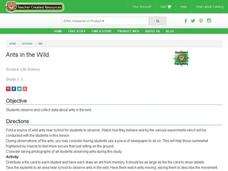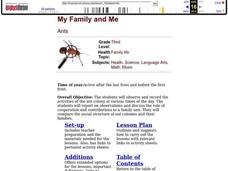The New York Times
Trouble in the Hive: Researching the Decimation of Honeybee Colonies
Teach your class about colony collapse disorder and foster discussion about causes and solutions for the honeybee problem. Class members read and discuss an article and participate in one of two detailed activities about pollination and...
Curated OER
Book: The Northern Colonies: Quest for Freedom
Students, after reading Chapter 1 in the book, "The Northern Colonies: Quest for Freedom," assess the diseases that killed Native Americans as well as the causes for the spread of disease during this time period. They contemplate medical...
Curated OER
Martian Colony Proposals
Ninth graders design a proposal for a Martian colony to be presented to a group of their peers. They review their knowledge of Mars. Students evaluate for themselves which of their classmates proposal best fits their criteria.
Curated OER
Settlement Exploration: Then and Now
NASA has crafted an imaginative and memorable series of lessons, "NASA and Jamestown Education Module." This lesson is one of the five components. In it, middle schoolers connect history and science by comparing the settlement of...
Curated OER
The Disappearing Honeybees: Tracking Honeybee Decline
Students practice graphing and other math skills to track number of honeybee colonies present in United States since 1978, discuss major crops that are dependent on insect pollinators, and examine reasons for decline of United States...
Curated OER
Living On The Moon
Learners evaluate what life would be like living on the moon or another planet in our solar system. In this science lesson, students create a colony that they would use to live in on the moon using Legos.
Curated OER
Biotechnology Laboratory Research
Learners participate in an extended laboratory research to experience how scientific information is obtained, upon which we build scientific knowledge and understanding.
Workforce Solutions
A Colony for Lunar Living
Two lessons explore the possibility of living on the moon. First, scholars read various scenarios to identify which careers would best transfer to life in space. Finally, pupils examine a website to locate items made for outer space,...
Curated OER
Ant City
Students develop an ant colony that adults and children can visit. Students create different areas including places where tourists can view live ants, play ant games, research facts about ants, and create ant art. Students serve as...
Curated OER
A Little More Advanced Biotechnology Tools: Better Plasmids
A nice set of information that will help your students understand the process of using recombinant plasmids. DNA hybridization and blotting mechanisms help illustrate expressed genes and the concepts behind the Human Genome Library....
Curated OER
WebQuest Solar System Colonization Project 2000
Sixth graders decide what would be needed to survive in space and use information collected in a WebQuest to find 10 places in the Solar System to create a space colony.
Curated OER
The Queen's Empire
Students conduct Internet research on a variety of ant species and their habitats. They have an opportunity to observe ants in their environment. Areas of interest might include ant identification, colony life, the ant life cycle, and...
Curated OER
The Peanut Wizard
Students read and discuss information regarding George Washington Carver and how the peanut became cultivated in the southern colonies of the United States. In this George Washington Carver lesson plan, students develop vocabulary that...
Curated OER
Ants in the Wild
Students investigate ants in the wild. In this insect lesson, students observe ant colonies and conduct experiments, such as putting food in the ants' path. Students record their observations.
Curated OER
Sponges, Cnidarians, Flatworms, and Roundworms
In this simple animals activity, students read information about sponges, cnidarians, flatworms, and roundworms and then complete a chart comparing and contrasting these groups of animals. This activity has 11 fill in the blank questions.
American Museum of Natural History
You are the Queen
A day in the life of a wasp queen is not as royal as it may sound. Pupils assume the role of the wasp queen to complete an interactive activity that simulates building a colony. They make decisions along the way and note the changes from...
Nuffield Foundation
Making a Streak Plate
Cultivate bacteria with a straightforward lesson featuring agar. Scholars create a streak plate on agar to ideally create colonies of bacteria or yeast that are growing separately from each...
Curated OER
Bacteria Buddies
Tenth graders grow two different bacteria cultures. They count the colonies, and then use graphing calculators to predict the number of colonies that are going to appear. Students answer questions from their worksheet after completing...
Curated OER
Egg Carton Coral
Students use egg cartons to construct models of coral colonies showing
many aspects of the coral's natural history - including the structure of
coral polyps and the coral colony's colonial life style.
Curated OER
New Ship For the Old World
Students explore the age of sailing in the colonies through role-playing. In groups, they play the role of a business owner, shipbuilder and geographer to complete specific tasks. They participate in an old World trade show to...
Curated OER
The Life Of Bees
Students explore the matriarchal structure of a bee colony. They participate in various activities to identify the structure of a bee colony and the roles of each type of bee plays in the colony. Vocabulary and a worksheet with answer...
Curated OER
My Family and Me
Third graders observe and record the activities of the ant colony at various times of the day. They report on observations and discuss the role of cooperation and contributions to a family unit. They compare the social structure of ants.
Curated OER
Mealtime for Corals
Students explore how coral polyps feed. For this science lesson, students participate in an interactive game to demonstrate how polyps within a coral colony feed. Students become coral polyps and demonstrate how they feed in this lesson.
Curated OER
What Color is Your Colony?
Students conduct an experiment to change the color of E. coli bacteria using genetic engineering. They work in small groups to add a plasmid containing a gene for red pigment to the bacteria and culture the bacteria to see if it ...
Other popular searches
- Thirteen Colonies
- 13 Colonies
- American Colonies
- New England Colonies
- Middle Colonies
- Southern Colonies
- 13 Colonies Maps
- 13 Colonies Activities
- Settling the 13 Colonies
- Us Map 13 Colonies
- British Colonies
- Middle and Southern Colonies























